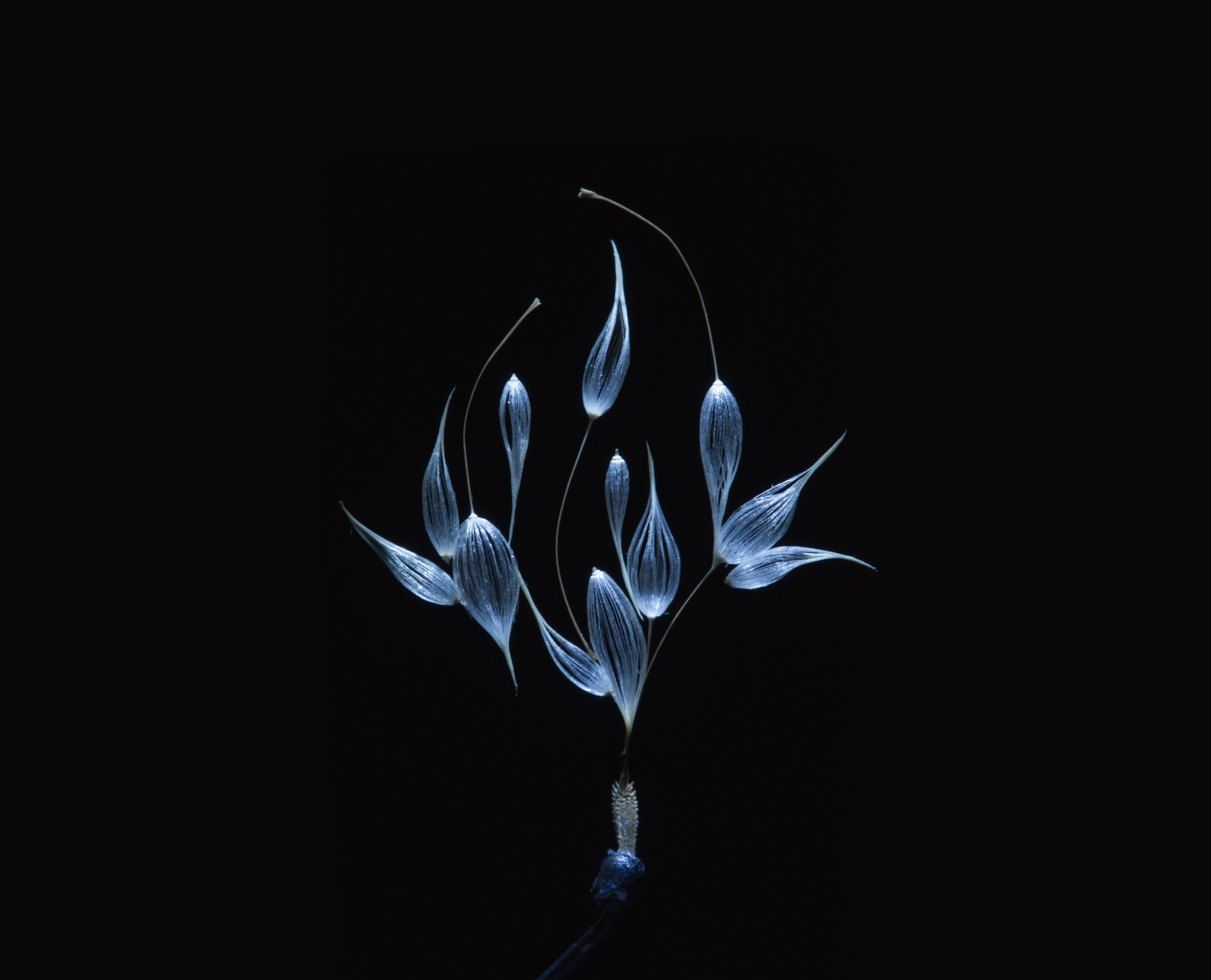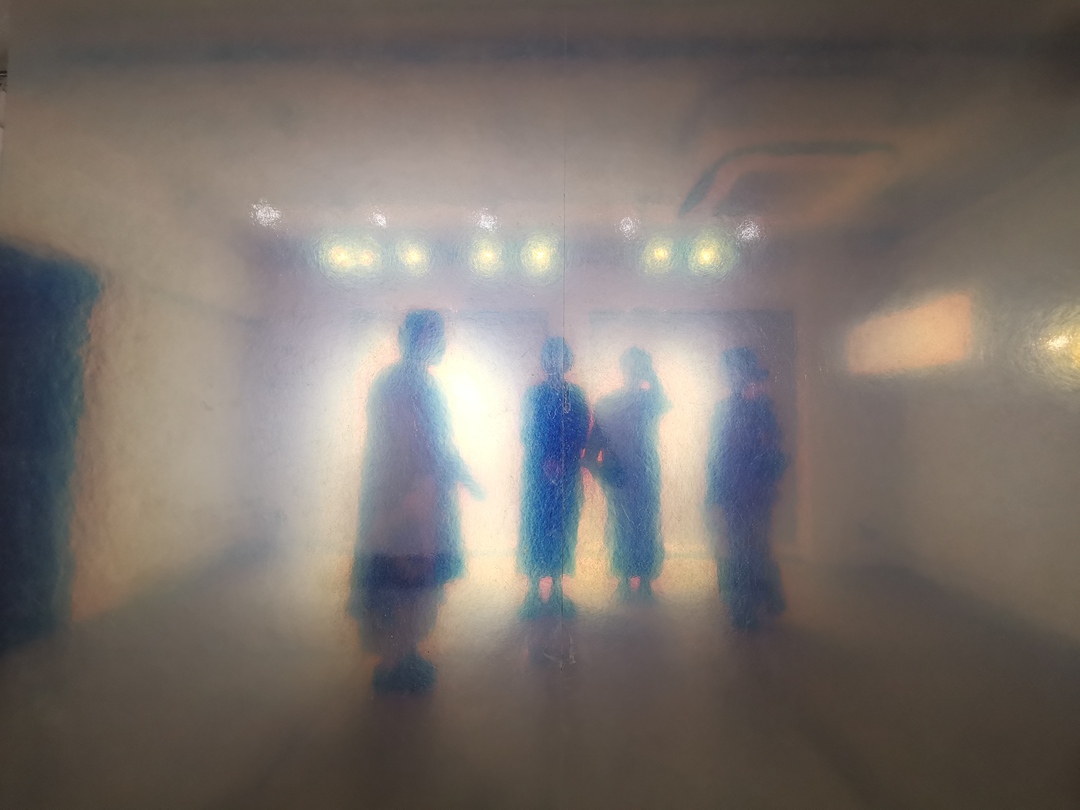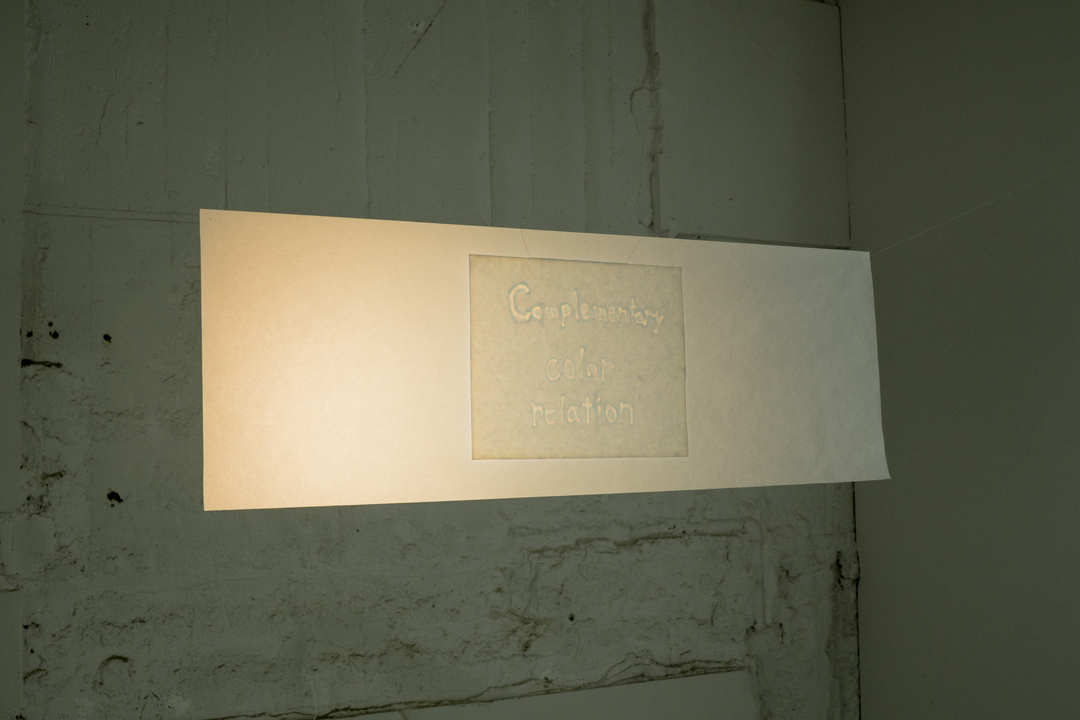My Mythos and the Logos of my Heart:
-From Watage to the exhibition “If you find a fascia”-

About Watage's artwork:
(euglena) started creating Watage when she was studying media art, mainly using electronic work and programming as a means of artistic expression. She wanted to create works that had a different flow of time than the speed at which technology trends come and go, and at the time, she was interested in interactive works. "Interactive" means that the work responds to the viewer's actions, and it feels like a proof of existence that says, "I am here." Works that respond to one's actions were an existence that made (euglena) feel the reality of being here. However, when the power supply is cut off, those works are also wrapped in a lonely silence. Looking back now, (euglena) may have been searching for the "eternity" that humans fundamentally seek.
So, while searching for a new method of expression, one day in late April, she saw dandelion fluff dancing in the wind. In today's society, which is dependent on electricity, dandelion fluff flying on the power of the wind seemed very fresh to (euglena). That's why she created Watage. The small breeze that is born when a person approaches and the Watage that moves with the flow of the atmosphere in the space are simpler compared to conventional interactive works, but (euglena) believes they are works that strongly make the viewer feel their presence in the space.
3 themes of watage
Watage's works are based on three themes: motion, stillness, and aloof.
The "motion" theme is the first type of work that was created, and it moves in response to the slight influence of its surroundings.

The "stillness" theme uses processed cotton fluff that has been soaked in water. In contrast to the cotton fluff that flies in the wind, this work is quiet and has a sense of hardness.

The "aloof" theme uses cotton fluff that has not been pollinated. The un-pollinated seed is completely white up to the point where it becomes a seed. The cotton fluff without seeds can fly farther than most and is light, but it will never sprout even if it lands on the ground. The artist was fascinated by the cotton fluff without seeds itself, rather than its role, and wanted to acknowledge it as an artwork.

To recognize oneself in purity
The artist at the time created the artwork by fitting appropriate words together like a collage when writing the concept. This is because the artist felt that trying to explain a sensory work with logic would actually detract from the flavor of the piece. Therefore, the written concept is as follows:
Dandelion fluff of weightlessness that cannot be sensed even when placed on the palm of one's hand.
The accumulation of these fibers, or "watage", reacts to the faint currents of air generated by the viewer's movements and breath.
Without relying on artificial power, the impact on the surrounding area that has been visualized will allow one to recognize oneself in purity once again.
How long will the "watage" continue to sway?
One day, when this piece has withered away, we dream of the day it will be planted in the earth and once again sprout forth."
The accumulation of these fibers, or "watage", reacts to the faint currents of air generated by the viewer's movements and breath.
Without relying on artificial power, the impact on the surrounding area that has been visualized will allow one to recognize oneself in purity once again.
How long will the "watage" continue to sway?
One day, when this piece has withered away, we dream of the day it will be planted in the earth and once again sprout forth."
She" feels that the collage-like text that was created fits perfectly with the artwork, but honestly, she often finds herself not fully understanding it. In particular, the phrase "to rediscover oneself in purity" from the concept above remains an important question for her even now.
Meeting with Anima/Animus
In 2019, (euglena) entered graduate school and changed her major and university. During that time, there was a growing discussion on feminism and women's rights. It was a time when she had many opportunities to think about being born as a woman, and she created a work called "Old internet". This work is a piece of light and color that appears to the viewer and the object through the work as a yellow to blue gradient image. It expresses the anonymity and freedom of the internet as a theme, and represents the internet world of the 2010s. At that time, the real world and the internet world were clearly separated, and I feel that it was a place where people could enjoy free self-expression. Also, She feel that the gradient of blue and yellow, which are opposite colors (complementary colors), found harmony and integration in what was separated.


Afterward, she encountered Jungian psychology. According to this theory, there exist both femininity and masculinity within the human psyche, which are called the anima and animus, respectively. Femininity represents sensation, emotion, and the source of life, while masculinity represents order, reason, authority, and so on. Humans are said to inherently possess both femininity and masculinity. She resonated with this theory and became interested in studying psychology.
In 2020, after graduating from graduate school, she aimed to work overseas, but unfortunately had to give up that plan due to the COVID-19 pandemic. She then decided to work at a head massage shop to not only gain knowledge but also to experience the intangible, the unconscious. The shop she worked at specialized in sleep and was a place where people who suffered from insomnia or fatigue gathered. According to Jungian psychology, "Dreams are the direct expression of unconscious mental activity" (quote: "Jung's Dream Analysis," C.G. Jung, Misuzu Shobo, p.5). She thought that by observing sleep, she could touch upon the unconscious and observed the sleeping faces of hundreds of strangers from a wide range of age groups, from their 20s to 70s.
During treatment, even those who said they couldn't sleep had a high chance of falling asleep, but there were also people who expressed the state of "not being able to sleep" due to movement in their bodies. As sleep began and became quieter, the body's restlessness slowly began to appear. Some people stiffened their necks, others chattered their teeth or made clicking sounds, while others ground their teeth or moved their blanket-covered stomachs like another creature. Some people woke up because of the sound of their own jaw during sleep or couldn't achieve deep sleep due to movements in their bodies while sleeping. One day, after a man she treated fell asleep for a while, he murmured, "Help me." It was a strongly suggestive sleep-talking message that she had never heard before, so she asked the man about it after the treatment, but he had no recollection of it. At that moment, she remembered the words of the psychologist Hayao Kawai, "Something is wriggling where the light of the ego cannot reach" (quote: "The Structure of the Unconscious," Hayao Kawai, p.398), and was deeply moved by the depth of the unconscious.
About the 2023 exhibition "If You Find Fascia"
When she started studying massage, not just for the head but for the whole body, she encountered "fascia", which became the title of the exhibition. When you think of massage, you often think of Shiatsu, which mainly loosens stiffness by pressing hard, but if you press too hard, you can actually damage your muscles and make the stiffness worse. The difference in the approach to fascia is that it is not a strong massage like Shiatsu. Unlike traditional acupressure, it is a method of softening the targeted muscles and organs through small, indirect actions such as "stroking" and "gently lifting the skin". This method not only loosens the muscles but also relaxes the psychological tension in the body, working on both the body and mind.
Fascia is an important tissue that covers not only muscles but also all organs, connecting them and carrying information, but it was not discovered in anatomy until 2018 because it could not be found even when dissecting a corpse. From there, it seems that she learned from fascia about something that can only be seen while alive, something small and overlooked in everyday life that connects and sustains the whole, which for some people could be connections, memories, soul, faith, or culture.
Fascia is an important tissue that covers not only muscles but also all organs, connecting them and carrying information, but it was not discovered in anatomy until 2018 because it could not be found even when dissecting a corpse. From there, it seems that she learned from fascia about something that can only be seen while alive, something small and overlooked in everyday life that connects and sustains the whole, which for some people could be connections, memories, soul, faith, or culture.


The new work "homesickness (never been)" at this exhibition.
The concept of the exhibition is the overall framework, and behind it lies the heart.
The new work in this exhibition, "homesickness (never been)," occasionally makes the artist think, "I want to go back," when she sees a piece of artwork that she likes. This is because there is a place that guides her somewhere that is not home. To express our hearts, the artist incorporates the technique of sandplay therapy. This is a method in which a person's heart is expressed by placing miniatures of plants, animals, buildings, etc. in a box filled with sand. It is an attempt to see what kind of things can be created simply through "selection and arrangement," not "drawing" or "making."
In this work, the artist used a postcard-sized paper as the box of sandplay therapy and arranged various patterns of patches and masking tapes as two-dimensional miniatures. While selecting and arranging what suited her heart, the remaining elements were tulip patches and window-patterned masking tapes. With the placement of the window, a space is created where tulips stand. The tulips feel like they represent humans.
The new work in this exhibition, "homesickness (never been)," occasionally makes the artist think, "I want to go back," when she sees a piece of artwork that she likes. This is because there is a place that guides her somewhere that is not home. To express our hearts, the artist incorporates the technique of sandplay therapy. This is a method in which a person's heart is expressed by placing miniatures of plants, animals, buildings, etc. in a box filled with sand. It is an attempt to see what kind of things can be created simply through "selection and arrangement," not "drawing" or "making."
In this work, the artist used a postcard-sized paper as the box of sandplay therapy and arranged various patterns of patches and masking tapes as two-dimensional miniatures. While selecting and arranging what suited her heart, the remaining elements were tulip patches and window-patterned masking tapes. With the placement of the window, a space is created where tulips stand. The tulips feel like they represent humans.

Relevance revealed by Tulip
During the exhibition, she was asked why she chose tulips as a component rather than other flowers. Looking back, she thought that tulips, even when in bloom, give the impression of being closed, unlike other flowers. By the time the stamen and pistil become visible, the flower has already exceeded full bloom. She found it very interesting that the typical image of tulips is that they contain the stamen and pistil without showing them. Plants are hermaphroditic, and this idea is reminiscent of the concept of anima/animus. Upon investigating this commonality, she came across Goethe.
It may be surprising why this has not been noticed before, but Jung's works also quote Goethe, and Goethe's idea of the male aspect in the vertical structure of the spiral movement of plants and the female aspect in the spiral structure is very similar to Jung's concept of anima/animus. Concerning opposing aspects, Goethe states: "So let us return to the most universal thing, and recall the claim that the systems which aim at the vertical and those which aim at the spiral are intimately connected in living plants, as we already stated at the beginning. Now, if we admit that the vertical system is clearly male, and the spiral system is clearly female, then we can imagine how all the growth of plants, beginning from the roots, is secretly linked in hermaphroditic union. Thus, in the process of various changes in growth, the two systems clearly oppose and divide while claiming their own dominance, but ultimately they aim to become one again in a higher sense" (from "The Spiral Tendency in Vegetation" in the Hamburg edition of Goethe's complete works, HA XIII, 148). This is similar to Jung's concept of anima/animus, which has four stages of development for the anima: physical, romantic, spiritual, and wise, and four stages for the animus: power, action, speech, and meaning. The idea is that the female and male aspects within an individual develop, sometimes with opposition and resistance, and then are integrated on a higher level.

This is a translation of a passage about the artist Euglena and her early work, Watage:
From the question posed in Watage, "What does it mean to rediscover oneself in purity?", (euglena) felt that she was on a quest to explore her own path. However, every time she found commonalities in what she was seeking, she felt like she was orbiting around something like satellite. Perhaps it could be called a habit. (euglena)'s name means "euglena," a type of algae. Her father is of Chinese-Thai descent, and her mother is a Japanese-Peruvian born in Peru. With such a background, she felt like she didn't know to which side she should belong. Amidst this confusion, she found a commonality with euglena, which is a type of algae that acts like an animal cell even though it's a plant cell, and decided to use it as her name. She finds herself in the unity of seemingly unrelated or opposite elements and creates a work of art, seeing it as her own child.
Closing and opening, clapping hands, closing,
Opening again, waving hands,
Raising those hands up high.
(euglena)
Opening again, waving hands,
Raising those hands up high.
(euglena)